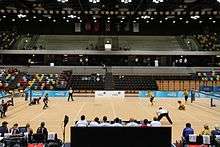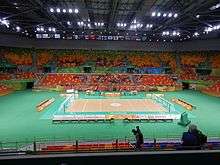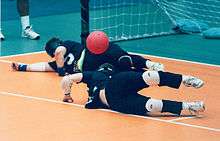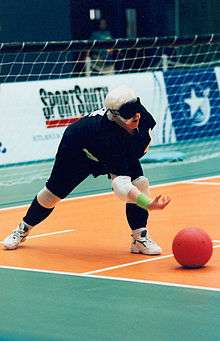Goalball
Goalball is a team sport designed specifically for athletes with a vision impairment. Participants compete in teams of three, and try to throw a ball that has bells embedded in it into the opponents' goal.[1] The ball is thrown by hand and never kicked. Using ear-hand coordination, originating as a rehabilitation exercise, the sport has no able-bodied equivalent. Able-bodied athletes are also blindfolded when playing this sport.

Played indoors, usually on a volleyball court, games consist of twelve-minute halves (formerly ten-minute halves).[1] Teams alternate throwing or rolling the ball from one end of the playing area to the other, and players remain in the area of their own goal in both defence and attack. Players must use the sound of the bell to judge the position and movement of the ball. Eyeshades allow partially sighted players to compete on an equal footing with blind players.[1] Eyepatches may be worn under eyeshades to ensure complete coverage of the eye, and prevent any vision should the eyeshades become dislodged.
The International Blind Sports Federation (IBSA), founded in 1981 and responsible for a range of sports for the blind and partially sighted, is the official governing body for the sport.
History
Goalball was originally devised in 1946 by the Austrian Hanz Lorenzen and German Sepp Reindle as a means of assisting the rehabilitation of visually impaired World War II veterans.[2]
Goalball gradually evolved into a competitive game during the 1950s and 1960s. It was eventually nominated as a demonstration sport at the 1972 Summer Paralympics in Heidelberg, West Germany, and became a Paralympic Games sport in at the 1976 Summer Paralympics in Toronto.[3][2] The sport's first world championship was held in Austria in 1978.
In 2011, the long-standing IBSA Goalball Subcommittee sought to separate from IBSA and form a new international body, the World Goalball Association. This was for several reasons. IBSA responded by appointing a new committee.
As of 2017, there were 81 competing nations, and 270 international referees.[3]
Essentials
Court and ball

IBSA goalball rules require the field of play to be 18 metres (59 ft) long by 9 metres (30 ft) wide.[4] Goals span the width of the pitch.[5] The court is divided into six even sections, 3 by 9 metres (9.8 by 29.5 ft). At either end, just in front of the goal, is the team area. Beyond that is each team's landing zone. The middle two sections are collectively referred to as the neutral zone.
The lines of the court are made by placing tape over lengths of twine. This makes the line both visual (for officials) and tactile (for players). The team area and landing zone, including the boundary, goal lines and high-ball lines, are always marked in this way. Furthermore, the team area has six hash marks (three at the front, one on either side, and one on the goal line) to assist with player orientation.
The ball weighs 1.25 kilograms (2.8 lb) and has eight holes and contains several noise bells. The ball's diameter is around 24 centimetres (9.4 in).[5] A non-official ball of about 0.9 kilograms (2.0 lb) has also been produced by several companies for use by younger players. At Paralympic Games level, the ball has been measured leaving the hand in excess of 60 kilometres per hour (37 mph). Despite this, through training and some padding, there are very few injuries.
Officials

Unlike most games, there are more officials than players on the court:
- referees (two). Each referee remains along the sideline at one half of the court. One referee is 'table-side', the other 'off-table side'.
- goal judges (four). Positioned to the side of each goal edge, goal judges are crucial to the game's speed, retrieving a ball going off court, and dropping it at the side hash mark of the team area so play can resume.
- ten-second timers (two). Keep track of the time between when a defending player contacts the ball and when the ball is thrown, calling '10 second' (akin, but not to be confused with, delay of game) penalties when applicable. The role was expanded in the 2018 rule changes to include watching for eyeshade and illegal coaching penalties.
- scorer. This technical official keeps track of the number of time-outs and substitutions taken by a team and, as the term suggests, keep score.
- game timer, and back-up timer. Usually, as with a basketball scoreboard, the period's time counts down to zero. It is stopped and started by the referee's whistle. A back-up timer is used in case of power failure to the venue.
Players
Each team has three players on the court at a time, with one to three substitute players on the bench. At a regional championship, the World Championships, or Paralympic Games, the competition is divided into two categories, male and female; at other levels, this is a matter for the local organising committee.
There are three standard positions to play. Players, while there is typically no official designation, often have a position they are best at or prefer, though some players will play any of the three.
The centre player is the player most responsible for defence. They typically line up at the centre hash-mark at the front of the team area, though there are various defensive arrangements. The centre player is the most defensive position simply because they must be able to move both to the left and right to defend. They are also typically the defensive coordinator, as they can more accurately determine which opposing player has the ball due to being square to the opposing team.
The left and right wings generally line up at the end of the hash marks coming off of the respective sidelines. Their main defensive responsibilities are keeping the ball out of either corner of the goal, though they also defend some towards the centre. Typically, the wings are the main offence, allowing the centre player to reserve their energy for defence, while they attempt to score. This is not to say that the centre player is not also an offensive threat, just that they generally are more focused on keeping the ball out of their own net than putting it into the opponents'.
Scoring
A goal is one point and is scored when the ball completely crosses the goal line. The team with the higher score at the end of regulation time is the winner. If regulation results in a tie, two three-minute overtime periods are played, for a golden goal (first goal concludes the game). If no goal scored during overtime, penalty throws and sudden death penalty throws are taken. Scores can be an intense 1:0, or 8:15. When a maximum goal difference of ten is reached, a mercy is called and the leading team is declared the winner.
Game play and etiquette
For the crowd, because the game relies heavily on the sense of hearing instead of sight, all outside noise, including cheering, clapping, chanting or ringtones from cellphones, is prohibited. Coaches cannot bark out orders to influence the game. Players, regardless of level of vision, are blindfolded.
Beginning of play
Unlike Dodgeball, netball or handball, the designated home team start the game by throwing the ball underhand from their own goal.
Offence
To score, a player must roll or bounce the ball down the length of the court, past the opposing defenders, and into the opponents' goal. Typically, the player with the ball will stand, orient themselves using the tactile lines, sounds from teammates, and/or the crossbar of their own goal. The player will then stride forward, lean low, and roll or side arm the ball down the court.
The ball must hit in the player's own landing zone, and anywhere in the neutral zone. So long as it hits each zone, the style of throw is entirely up to the player in question. Many players will take several strides and release the ball as close to their own high ball line as possible; leaning low to ensure a legal throw. Some players will throw after spinning; transferring the momentum of the spin into additional velocity. Others are able to throw the ball so that it will bounce just once in each of the required zones. Most elite players are effective when using multiple types of throws.
Defence
The defending players stay within the team area, generally in somewhat staggered positions to avoid collisions. When they hear the other team throw the ball, they 'lay out', that is slide on their hips and stretch their arms above their heads and extend their legs in order to cover as much distance as possible. The objective is simply to keep the ball from getting past with whatever part of the body the player can get in front of it.
Some players prefer to block the ball with their chests and absorb the impact. Others like to block with their legs so that the ball will roll up their bodies into their hands. Regardless of method, the players will always try to make themselves as long as possible to block the greatest area.
Rules
Infractions
Infractions are generally punished by the loss of possession to the other team
- Premature throw – Throwing the ball before the official has called 'play'.
- Ball over – The ball rebounds off a defending player, the crossbar or goalposts and crosses back over half-court.
Penalties
A penalty throw may be awarded for:
- Ten second penalty – A team takes more than ten seconds to throw the ball back over the centre line.
- Delay of game – This can be caused by many different things. A coach reporting the wrong numbers for substitutions, a team not arriving in time for the coin toss that precedes the game, or too many or too few players taking the court.
- Illegal defence – This is called if a defender makes contact with the ball while no part of the body is touching the team area.
- Short ball – The ball fails to reach the opponent's team area when thrown.
- High ball – The ball does not touch the thrower's landing zone when thrown.
- Long ball – The ball does not touch the neutral zone when thrown.
- Eyeshades – Touching eyeshades without permission.
- Unsportsmanlike conduct – This can be a variety of things, from arguing with an official to pounding the floor and swearing
- Noise – Unnecessary noise by the offensive team that prevents the defence from tracking the ball while the ball is travelling down the court.
- Illegal coaching – Coaching from the bench during play or after an official has said 'Quiet please' with intentions of continuing or starting play. From 2006, rules allowed coaching from the bench during an 'official time-out'.
In a penalty situation a single player is required to defend the entire goal for one throw. The player chosen is determined by the penalty. For instance, a high ball or illegal defence penalty is defended by the player who committed the penalty. On the other hand, an illegal coaching penalty is defended by a player chosen by the coach of the throwing team (previously the last recorded thrower of that team).
Official rules
The official rules for the sport are provided on the IBSA website.[3] Rules may be adjusted every four years.
Referees may be internationally certified under a structured scheme, from IBSA Goalball Level 1 to Level 3. Goalball world championships and Paralympic Games tournaments are called by Level 3 referees.[3] Participating countries may also have a national referee scheme.
Changes over time have seen regulation period halves increase from seven, to ten, to the present twelve minutes. Team staff were limited to when coaching could occur, but now is after any whistled stoppage in play. Rules such as step-over and third-time throw have been removed. The ball must be thrown back at towards the opposition goals within ten seconds from contact. In 2014 this was extended to reaching the centre line to ensure a quicker delivery. Eye patching was introduced under the eye shades to reduce cheating.
Competitions and events
Goalball is a sport played at the Paralympic Games. During the Games, ten male teams and ten female teams are eligible to compete following various selection requirements.[6] Competition is open to sighted persons to national level, but for international IBSA-sanctioned tournaments, athletes must have a visual impairment classification of B1, B2, or B3.[3]
The IBSA World Goalball Championships has been held every four years, since 1978. A youth world championships was introduced, and the Fifth IBSA Goalball World Youth Championships were run in Budaors, Hungary in July 2017,[7] the first outside of Colorado, United States of America.
Diving as part of defensive skills has been used as a training activity for (sighted) sports teams. Professional teams trying goalball have included the Boston Bruins ice hockey,[8] Queensland Fire cricket,[9] and Seattle Sounders FC soccer.[10] teams.
Gallery
 Goalballer Sarah Kennedy (Qld) makes a save for Australia at the 1996 Atlanta Paralympic Games
Goalballer Sarah Kennedy (Qld) makes a save for Australia at the 1996 Atlanta Paralympic Games Goalballer Raelene Bock (NSW) competes for Australia at the 1996 Summer Paralympics
Goalballer Raelene Bock (NSW) competes for Australia at the 1996 Summer Paralympics
In popular culture
Goalball was featured in episodes 10-12 of the 2020 Japanese anime, Breakers, where Paralympic sports are featured, as originally planned to promote 2020 Summer Paralympics.[11]
See also
- Goalball at the Summer Paralympics
- World Goalball Championships
- Paralympic Games goalball athletes
- Torball
References
- "Goalball - Paralympic Athletes, Photos & Events". Paralympic.org. Retrieved 6 March 2015.
- "BBC SPORT | Other Sport | Disability Sport | Paralympics - goalball". BBC News. 18 October 2004. Retrieved 6 March 2015.
- "Goalball - General information". International Blind Sports Association. Retrieved 9 December 2017.
- "授乳後のバストアップ". Ibsa-sports.org. Retrieved 6 March 2015.
- Archived July 12, 2007, at the Wayback Machine
- "Participation". Explanatory Book: Goalball. Sydney Paralympic Organising Committee. 1999. p. 27.
- "Final Results: 2017 IBSA Goalball World Youth Championships". International Blind Sports Federation. 9 July 2017. Retrieved 9 December 2017.
- "Boston Bruins on Twitter: "Goal Ball time! Jarome & Reilly got to spend time today with students at @Perkins_School for the Blind". Twitter.com. 22 January 2014. Retrieved 6 March 2015.
- "Queensland Fire volunteer for goalball". Australian Cricketers' Association. 8 October 2014. Retrieved 9 December 2017.
- "Goalball | Seattle Sounders FC". Soundersfc.com. 5 November 2012. Retrieved 6 March 2015.
- "Watch Breakers Episode 11 English Subbedat Gogoanime". Gogoanime. Retrieved 24 April 2020.
External links
| Wikimedia Commons has media related to Goalball. |
| Wikinews has related news: |
- International Paralympic Committee page on goalball
- Beijing 2008 Paralympic Goalball Information with an Australian slant from accessibility.com.au
- BBC Sport article with video and commentary on what Goalball is
- Goalball Australia
- International Blind Sports Federation (IBSA) on goalball